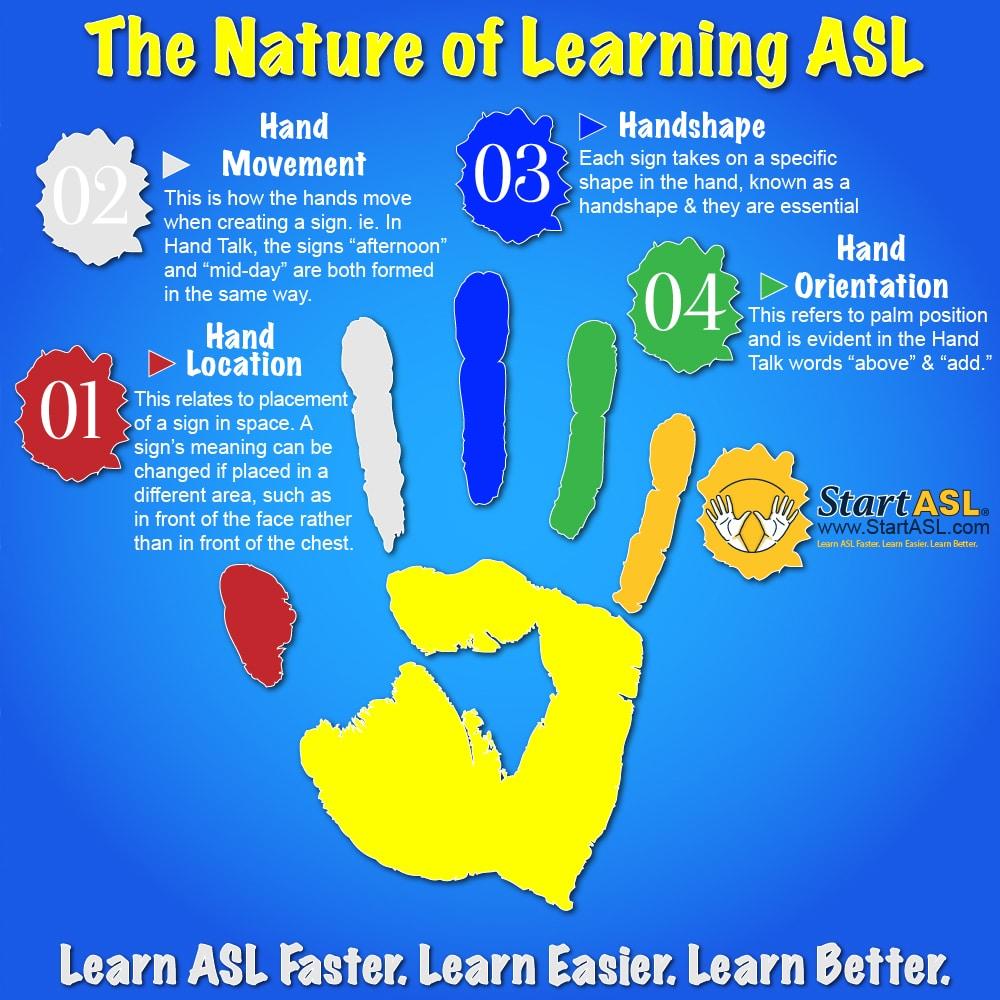
Centuries prior to the development of American Sign Language, Native American Sign Language, also called Hand Talk, was developed. It features four essential parameters: hand location, hand movement, hand shape, and hand orientation:
1. Hand Location: This pertains to proper positioning of a sign in an area. A sign’s meaning is modified when placed elsewhere, for instance in front of the face as opposed to in front of one’s chest.
2. Hand Movement: This one involves how one's hands move when making a sign. As an example, in Hand Talk, the signs “afternoon” and “mid-day” are formed in a similar manner. The only variation is that mid-day is stationary, and afternoon moves from above the head to the side of the head in an arching motion.
3. Handshape: Each sign forms a specific shape in the hand, referred to as a handshape. The handshapes of signs are essential factors. As an example, the signs for “yes” and “I know” are the same in most aspects apart from the handshape; in “yes” the hand forms the characteristic J shape, whilst in “I-know” the hand forms the L shape.
4. Orientation: This represents palm position which is noticeable within the Hand Talk words “above” and “add.” The two signs require using the left-hand to form a base, through which the right-hand rises, and both have similar locations, movements, and handshapes. On the other hand, once signing “above,” the non-dominant hand is positioned palm down, while in “add” the non-dominant hand is palm upwards.
Hand Talk’s Influence on American Sign Language
Not one individual takes credit for making American Sign Language. It's heritage reaches back to early 19th century, when varieties of signs formulated in New England’s Deaf local communities. And during the latter section of that century, Hand Talk inspired the formation of ASL, but historians mostly disregard this fact.
Hand Talk has regional variations which exist all over North America. Some examples are a northeastern variant that ranges across the present-day New England, upper Midwest, and Mid-Atlantic states. Researchers believe this variant of Hand Talk considerably influenced the development of American Sign Language. This impact took place within the Nineteenth century through the signing of Native American children that attended the American School for the Deaf in Hartford, Connecticut. An internet-based video titled “The Hidden History of “Hand Talk” presents powerful data for Hand Talk’s influence on ASL and US culture.
Even so, despite its once-large quantity of users and robust impact on American Sign Language, Hand Talk is in decline. This effect is caused by the widespread depopulation and Americanization of Native North Americans over the past 200 years. For instance, in 1885, roughly 110,000 Blackfoot, Cheyenne, Sioux, Kiowa, Arapaho, along with other tribal peoples utilized Native American Sign Language or Hand Talk. However by the 1960s, merely a portion of this number exists. And in the 21st century, a small number of active Hand Talk users remained.
Much like the other native languages of North America, Native American Sign Language is decreasing in numbers. But while the volume of fluent signers might be minimal, the language continues to be used to varying degrees by some individuals of Siouan and Algonquian tribes.
In addition, activists like Deaf Cherokee researcher Dr. Melanie McKay-Cody of Arizona are working considerately to help keep North American Hand Talk alive. Dr. McKay-Cody works with tribal groups to help them protect their signed languages. She also advocates for Hand Talk to be utilized in the mainstream education of Deaf and Hard of hearing students. It is anticipated that such efforts can help Hand Talk to live on. In this manner, forthcoming generations can continue to use and relish the language and understand the rich cultural tradition from which it came.
